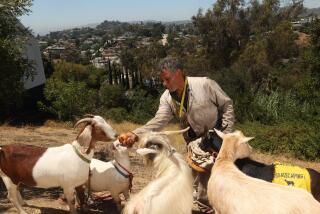Mallards Bring Dirt, Ducklings Into Pool
QUESTION: My problem is in trying to keep mallard ducks from nesting in my yard. I have a large pool and lots of shrubbery. Last spring I had a few females come and nest, use the pool and have babies.
I never fed the ducks, and my small dogs’ barking didn’t scare them away. When I called animal control and other agencies, I was told that there was nothing I could do and that if I interfered with the ducks I’d be fined $10,000.
In the meantime my pool was filthy and my dogs kept barking. I had a pool chlorinator shaped like a mallard duck, which I’ve since taken out, but the ducks still came. Please help.
J.C., Lake Forest
ANSWER: I sympathize. Getting the straight scoop on urban wildlife issues, both legal and technical, can be a chore. There are federal, state, and sometimes even local restrictions to be concerned with, and more often than not, everyone will give you a different answer.
I was a little skeptical about the $10,000 fine you were quoted for harassing ducks in your backyard. I checked both federal and state laws and called several agencies in Orange County.
It appears that whoever you talked with must have neglected to read the paragraph in the California Code of Regulations, Title 14, Section 251.1, which exempts landowners and their tenants from restrictions on harassing depredating wildlife.
Harassment, also called hazing, includes making noise, using nontoxic chemical repellents, using dogs to scare the birds off, etc. You may not, however, touch or pick up the birds or their eggs or nests, move them or harm them in any way.
The Migratory Bird Treaty Act, the federal document which gives protection to most bird species in North America, states in Part 21, “No permit is required merely to scare or herd depredating migratory birds other than endangered or threatened species or bald or golden eagles.”
I couldn’t find anything on a local level that would prohibit you from hazing the ducks in your backyard. So go ahead and try to keep them from landing, but remember that the longer the birds have been in your yard, the more difficult it will be to get rid of them. Anticipate their arrival and keep them from landing in the first place.
Many adult ducks use swimming pools as landing areas and then nest in nearby shrubs.
Strange as it seems, ducks are content to swim in chlorinated water. So short of emptying the pool each spring, you might try covering it. It may be a hassle, but consider that although the breeding season varies among individuals, most year-round mallards in the Southland nest in April or May and rejoin larger flocks by fall. You’ll have to be vigilant for only a few months.
If the ducks insist on landing and nesting once the pool’s covered, which I doubt will happen, you may need to consider modifying their habitat.
That means eliminating the cover--your shrubs--so vital to their ability to nest.
You are probably aware that hunters use duck decoys to attract ducks, so keep the duck-shaped chlorinator out of the pool permanently.
You didn’t mention whether you have a lawn area near the pool and whether the birds are loafing and foraging there. If so, there’s a nifty food-grade product on the market made from methyl anthranilate, the same biodegradable food-grade ingredient that gives some candy and gum its grape smell and taste.
Spray it on your turf, flowers and other plants to keep the ducks from nibbling everything in sight. You’ll know it works when they shake their heads and spit it out.
You can purchase ReJeX-iT AG-36 directly by calling the manufacturer, R J Advantage, at (800) 423-2473.
The product is being tested for use to break up bird roosts by using a fogger. If it continues to work in trials, it’ll be a slick way for homeowners to get rid of aggravating crow and starling roosts.
Last, in anticipation of their arrival next year, irritate them with brightly colored flags, balloons and noisemakers. If you see one landing in the yard, run out and bang a stick against the trash can and clap your hands.
Although these hazing techniques are temporary, they’ve been successful in driving waterfowl off agricultural areas when used early enough.
Be sure to have the pool drained and new water put in. It’s not unlikely that a person swimming in your pool with duck doo in it will become sick.
Thwarting Possums That Love Avocados
Q: I have been invaded by possums that raid my wonderful avocado tree, ruining the fruit by partially eating the mature avocados. I’ve tried baiting, setting animal trap cages and chasing them to no avail.
Please tell me how others deal with these creatures.
B.B., Compton
A: Opossums are one of the least understood and most common backyard critters.
The only marsupial found in North America, these cat-size mammals are basically shy and will go to great lengths to avoid a fight. Ironically, most people are afraid of them.
The truth is, they do “play possum” by rolling over and acting like they’re dead, although if backed into a corner they’ll show their teeth and make a threatening hissing sound. I’ve never heard of a case where an opossum was the aggressor in a fight. In fact, dogs are one of the main predators of opossums in suburban settings, and a big dog can easily kill an opossum.
Opossums are omnivorous, so anything from pet food left on the porch to the avocados in your tree is fair game. And they’re not difficult to trap because they aren’t wary. Perhaps you weren’t using a large enough trap.
Fortunately, you have two things in your favor. Opossums have large home ranges--up to 50 acres--and most young die in their first year. So unless you have a mother with infants, you’ll never have a population explosion in your yard, as you can with cottontail rabbits.
And once you’ve made the tree and other food sources unavailable to the opossum in your yard, it has ample areas to meet its needs elsewhere.
To keep the opossum out of your avocado and other trees, trim any drooping branches that provide access to the ground and put a two-foot band of galvanized metal around the trunk.
Although these are practically nonexistent in prefabricated form, you can rig one by buying aluminum flashing and some clips from the hardware store. Wrap these around the tree a few feet off the ground, six feet up if you have squirrels.
Encircle the band with springs and trim and band the trunks of any neighboring trees that might provide the opossum access to the avocado tree.
Opossums use ivy, tree cavities, stacks of logs and any other sheltered area for cover, so trim back vines and clean up any debris in the yard.
*
Got critter conflicts? Send your queries to wildlife biologist Andrea Kitay at P. O. Box 2489, Camarillo, CA 93011, or via e-mail to andrea@livingwithwildlife.com. Please include your name and city. Questions cannot be answered individually. For a list of Wildlife Bulletins that provide sound advise on homeowner-wildlife conflicts ($4 each), send a SASE to the above address, or visit https://www.livingwithwildlife.com.
*
A ‘Wild New Home’
* “Living With wildlife” is moving to a new home in the Thursday Home section of Southern California living, which debuts today in The Times.
More to Read
Sign up for Essential California
The most important California stories and recommendations in your inbox every morning.
You may occasionally receive promotional content from the Los Angeles Times.










